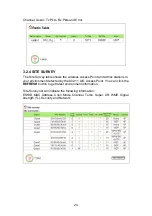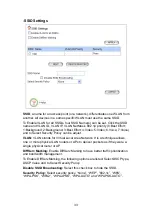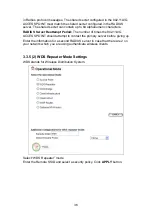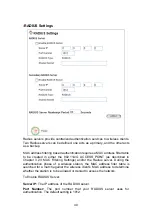
32
threshold must be transmitted following the RTS/CTS handshake exchange
mechanism. The RTS threshold should have a value between 256-2347 bytes,
with a default of
2347
. It is recommended that this value does not deviate from
the default too much.
Fragmentation:
When the size of a unicast frame exceeds the fragmentation
threshold, it will be fragmented before the transmission. It should have a value
of 256-2346 bytes, with a default of
2346
. If you experience a high packet error
rate, you should slightly decrease the Fragmentation Threshold.
DTIM Interval:
The 802.11A/G ACCESS POINT buffers packets for stations
that operate in the power-saving mode. The Delivery Traffic Indication
Message (DTIM) informs such power-conserving stations that there are
packets waiting to be received by them. The DTIM interval specifies how often
the beacon frame should contain DTIMs. It should have a value between 1 to
255, with a default value of
1
.
User Limitation:
The range of user limitation is from 1 to 100.
Age Out Timer:
Set the age out time. The default is 5 min.
Slottime:
Set slottime to “Short and Long” or “Long Only”.
Transmit Power:
Transmit power output depends upon the size and RF
characteristics because that will determine the number of APs, channels, and
need for antennas.
Rate Control:
Select a data transmission rate from the
Rate Control
dropdown menu.
AckTimeOut (11a)/ (11g)/ (Turbo-11g):
The "AckTimeOut" determines how
long the program waits after receiving a packet from a file stream to determine
that stream to be a complete file.
G Protection:
Select the check box to enable G Protection to
decrease the rate of data collision between 802.11g and 802.11b
and to maintain throughput of 802.11g.
Enable Radio eXtended Range:
Select the check box to enable
the Atheros®’s eXtended Range(XR) technology to extend the
wireless coverage range.
Enable privacy separator:
Select the check box to prohibit data
transmission between client stations.
Enable WDS:
Select the check box to enable WDS (Wireless
Distribution System).
Enable 802.11d:
Select the check box to enable 802.11d. 802.11d
is a standard for use in countries where systems using other
standards in the 802.11 family are not allowed to operate.
















































